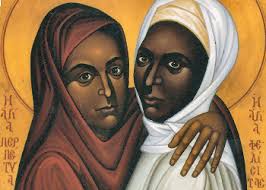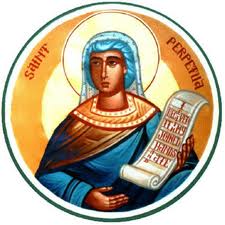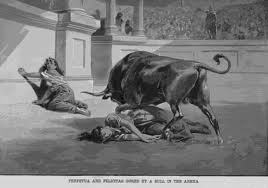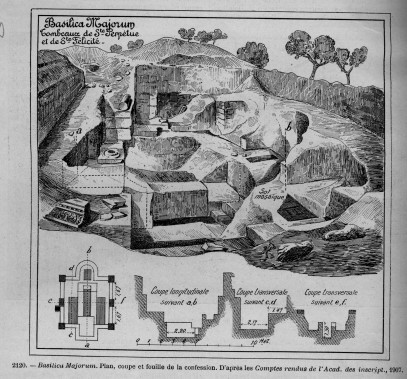
Summary: Ss Perpetua and Felicity, Martyrs. Perpetua and Felicity (believed to have died in 203 AD) were Christian martyrs of the 3rd century. Vibia Perpetua was a married noblewoman, said to have been 22 years old at the time of her death, and mother of an infant she was nursing. Felicity, a slave imprisoned with her and pregnant at the time, was martyred with her. They were put to death along with others at Carthage in the Roman province of Africa, during the reign of Septimius Severus.
 Patrick Duffy summarises what is known of them.
Patrick Duffy summarises what is known of them.
Perpetua and Felicity are two women who were martyred in the city of Carthage in North Africa (present-day Tunisia) and received great veneration from the 4th century onwards. The image shows them exchanging the kiss of peace in the arena as they are about to be martyred by wild beasts. Their names are included in the First Eucharistic Prayer (Roman Canon).
The Passion of Saints Perpetua and Felicity is a journal by the 22-year old Perpetua, who had given birth to a son a few months before. It tells of her trial and imprisonment and was continued by a contemporary who described Perpetua’s martyrdom in the arena. It was read almost like the Scriptures in the liturgies of north African churches. It is a rare surviving document written by a woman in the ancient Church. Their feast was commemorated in all early calendars and martyrologies.
Background
Perpetua was a young married woman of twenty-two and Felicity a slave-girl, far advanced in pregnancy. They were still catechumens when they were arrested at Carthage (near Tunis in present-day Tunisia) with four male catechumens under an edict of Emperor Septimius Severus (193-211) that forbade fresh conversions to Christianity. They were all baptised while they were kept under guard in a private house awaiting execution.
No fudge, no compromise
 Perpetua’s father urged her to renounce her faith and save her life and that of her baby. “Father,” she answered, “do you see this vessel – waterpot or whatever it may be? Can it be called by any other name than what it is?” “No,” he replied. “So also I cannot call myself by any other name than what I am – a Christian.” She was arrested by Emperor Septimus in the third century
Perpetua’s father urged her to renounce her faith and save her life and that of her baby. “Father,” she answered, “do you see this vessel – waterpot or whatever it may be? Can it be called by any other name than what it is?” “No,” he replied. “So also I cannot call myself by any other name than what I am – a Christian.” She was arrested by Emperor Septimus in the third century
Asked to offer a sacrifice for the prosperity of the emperors, she refused. When asked, “Are you a Christian?” she replied, “Yes, I am,” and so condemned herself to death.
Perpetua’s dreams of encouragement
A few days before the festival games, at which the martyrs would face wild beasts in the colliseum, Perpetua had a dream in which she was transformed into a man, and engaged in unarmed combat with an Egyptian (signifying the devil). “I was lifted up into the air and began to strike him as one who no longer trod the earth… I caught hold of his head and he fell upon his face; and I trod on his head,” she dreamt. The other captives also had visions, which fortified their courage.
Felicity gives birth in prison
Meanwhile, Felicity, fearing she would not have a martyr’s death with the rest, because Roman law forbade the execution of pregnant women, prayed her child would be born while she was still in prison. It was. A Christian couple promptly adopted it.
Agape before execution
Perpetua had managed to convert their jailer to Christianity, and so the captives were treated well in their final days. The prisoners turned their last meal into an agape, a love feast, and spoke of the joy of their own sufferings thereby astonishing most witnesses.
 In the arena
In the arena
As they went cheerfully into the arena, a wild heifer came and tossed Perpetua. She got up, straightened her hair, and helped Felicity to her feet. Absorbed in ecstasy, Perpetua was unaware that she had been thrown, and did not believe it until Felicity showed her the marks on her body.
Having survived the animals, the women were to be executed. They exchanged a final kiss of peace (see image). A nervous gladiator tried to kill Perpetua, but failed to finish the job until she guided the knife to her throat. “Perhaps so great a woman…could not have been slain unless she willed it,” the Passion observes.
Although the execution was intended as entertainment for the jeering crowd, some spectators, inspired by the martyrs’ fearlessness, became converts to Christianity. They died in 203 AD in Carthage.
Their veneration and memory
A magnificent basilica was erected over their tomb, the Basilica Majorum; that the tomb was indeed in this basilica has been proved by Père Delattre, who in 1907 discovered there an ancient inscription bearing the names of the martyrs.

Basilica Majorem of Ss Perpetua&Felicity
Their feast was commemorated in all early calendars and martyrologies on 7th March. It is mentioned in the earliest Christian calendar, the Roman Chronograph of Philocalus, written between 336 and 354 and is listed also in the so-called Martyrology of Jerome. Their names are also included in the First Eucharistic Prayer (Roman Canon) and in the Litany of the Saints.